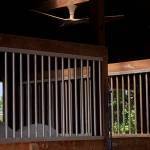Stressful Stabling Associated with Health, Performance Concerns

Increasing social interactions between stabled horses could improve trainability, performance, and welfare while decreasing aggression in public settings like shows or exhibitions. One potential way of allowing more frequent social interactions between horses is through the use of “social boxes” rather than conventional single-horse stalls.
Social boxes not only allow visual and olfactory recognition but also tactile contact between horses. A group of veterinarians at the Swiss National Stud Farm recently used social boxes to determine if physical and social interactions between horses would decrease when these same horses were driven as pairs.* The social boxes used in that study had vertical metal bars spaced so that horses are able to pass their head, neck, and legs into the adjacent box.
“The researchers theorized that increasing social interactions in the stalls would decrease distracting interactions during training, and overall performance would improve,” explained Kathleen Crandell, Ph.D., a nutritionist for Kentucky Equine Research.
Ten stallions used for driving were housed in individual box stalls for four weeks before being moved to social boxes. During the study, the stallions were driven for four consecutive days before, during, and after being housed in social boxes. The behavior of the stallions was then observed, noting whether each stallion aimed his head at the other horse during hitching, standing, or in movement, and whether the horses made other tactile contact.
This study found that horses performed more “social interactions” during the driving test before being housed in the social box. Those interactions decreased over the first few days of the study.
The researchers suggested that increased social contact during stabling may have decreased unwanted social interactions during training and performance.
In addition to minimizing the much-needed and normal species-specific interactions and behaviors, such as mutual grooming, single-stable housing may also be detrimental to horses by:
- Contributing to the development of stereotypical behaviors or aggression towards humans;
- Decreasing locomotor activity, potentially leading to unsoundness; and
- Developing stress-induced disorders such as gastric ulcers and hindgut acidosis.
“Management-related stress can also negatively affect the intestinal microbiome and cause a leaky gut,” said Crandell.
Leaky gut syndrome is a condition in which the tight junctions between individual cells lining the walls of the gastrointestinal tract break down. The resultant leaks allow bacteria and small food particles to pass directly into the horse’s bloodstream.
“Leaky gut results in low-grade systemic inflammation that often manifests as anxious behaviors, irritability, and discomfort. Therefore, protecting the health of the hindgut during stressful situations may help prevent leaky gut syndrome,” said Crandell.
She added, “EquiShure helps stabilize the pH of the hindgut, improving the environment for beneficial bacteria and making the gastrointestinal tract less hospitable for pathogenic bacteria that deteriorate and attack the tight junctions.”
*Gmel, A.I., A. Zollinger, C. Wyss, I. Bachmann, and S.B. Freymond. 2022. Social box: Influence of a new housing system on the social interactions of stallions when driven in pairs. Animals (Basel) 12(9):1077.








